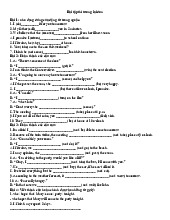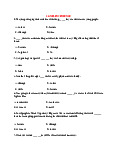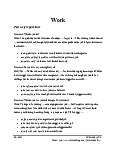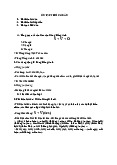






Preview text:
PRACTICE TESTS ON ENGLISH PHONETICS AND PHONOLOGY
I/ TRUE/FALSE: Decide whether each of the following statements is TRUE or FALSE.
Write the letter (T) or (F) right in front of the number of each sentence.
1. Phonetics is the study of human speech sounds. T
2. Three aspects of a speech sound as a physical event are: a- structure, b- arranging and c- auditory. F
3. Articulatory phonetics studies the ways in which speech sounds are produced. T
4. In describing articulation, we should know which articulators are involved in sound production. T
5. The tongue is a passive articulator. F
6. Sounds produced are influenced by the shapes of the cavities. T
7. Acoustic phonetics deal with how the speech sounds are produced by the listener. F
8. Auditory phonetics studies the speech waves. F
9. The main aim of phonetics is the study and identification of the distinctive sound unit. F
10. It is said that there are four stages in the speech chain: a- psychological, b- articulatory, c-
acoustic and d- interpretive. F
11. The larynx, which is situated in the upper part of the windpipe, contains the so-called vocal cords. T
12. The action of the vocal cords consists in their role as a vibrator set in motion by lung air. T
13. When the edges of the vocal cords are touching or nearly touching, the air passing
through the glottis will usually cause vibration, which produces voiced sounds. T
14. When the vocal cords are wide apart, the sound produced are voiced sounds. F
15. A vowel is a sound in the production of which there is a complete closure in the vocal tract.
16. The most important parts of the tongue for producing vowel sounds are front, central and back. T
17. Nasal, oral and pharyngeal cavities function as the principle resonators. F
18. The lip shape is important in producing either rounded or unrounded vowels. T
19. The main division of the roof of the mouth are dental, alveolar, hard palate and soft palate T
20. Phonology studies the phonemic system of a language. T
21. The approaches to the phoneme have seen it as a psychological entity, as a family of
sounds and as a functional unit.T
22. The functional view regards the phoneme as a family of sounds. F
23. The phoneme is a distinctive unit of sounds in a language. T
24. The allophones of a phoneme are concrete realizations of that phoneme. T
25. All phonemes can be regarded as being made up of a number of distinctive features. T
26. Allophones are made up of only non-distinctive features. F
27. The allophones of a phoneme are predictable phonetic variants of that phoneme. T
28. Phonemic transcription is based on the principle "one symbol per phoneme". T
29. RP is the standard New Zealand accent. It is the only accent studied. Other accents are
not important and, therefore, should not be taken into consideration.F
30. Speech sounds are divided into pure vowels and diphthongs. F 31. All vowels are voiced. T
32. A pure vowel is an unchanging sound in the pronunciation of which the organ s of speech
do not perceptibly change the position throughout the duration of the vowel. T
33. The front vowel is the one in the production of which the front of the tongue is raised in
the direction of the hard palate. T 1
34. According to the height to which a part of the tongue is raised, vowels can be classified into closed and open vowels. T
35. A close vowel is the one in the production of which the tongue is as low as possible. F
36. A rounded vowel is the one in the production of which the tongue is as low as possible. F
37. Vowels can be long or short. T 38. /i:/ is a long vowel. T 39. /e/ is a long vowel. F
40. A diphthong is a pure vowel. F
41. Diphthongs can be divided into centring and closing according to the second element of the diphthong. T
42. The word learn contains a diphthong. F
43. A consonant is a sound in the production of which no obstruction is formed in the mouth
by the active organs of speech. F
44. Consonants may be classified according to a- the organs of speech, and b- the manners of articulation. T
45. If we classify the consonants according to the state of vibration of the vocal cords, they can be voiced or voiceless. T
46. Labials consist of bi-labials and labial-dental. T
47. Palatals are sounds articulated in the glottis. F
48. A plosive is a stop consonant. T
49. A nasal is a sound formed by the tip of the tongue firmly pressed against the teeth ridge
or the teeth so that the air can escape at one or both sides of the tongue. F
50. The syllable may be defined as one or more speech sounds, forming a word or part of a
word, containing one vowel sound, with or without a consonant or consonants, and uttered at a single effort. T
51. The full internal structure of a syllable consists of onset and . F coda
52. In the word spring, /i:/ is the nucleus. F
53. Sun is a word of two syllables .F
54. The syllable structure of arm is CVC. T
55. Voiceless is a word with the point of syllable division after the sound /s/.T
56. A weak syllable is the one which might end in a syllabic consonant.T
57. Or is a syllable made up of one phoneme.T
58. A syllable which ends in a vowel is called a closed syllable. F
59. Correct syllable division is very important in communication. T
60. Word-stress can be defined as the tendency to pronounce the stressed syllable at more or
less regular intervals of time. F
61. The prominence in the word stress can be produced by the following factors: a- loudness,
b- length, c- pitch and d- quality. T
62. There is a strong tendency in the English language to stress the initial syllable in a word. T
63. English is a language which has fixed stress in the sense that the stress always falls on the last syllable in a word. F
64. If the second syllable of a two-syllable word contains a long vowel or diphthong, or if it
ends in more than one consonant, that second syllable is stressed. T
65. Three syllable simple nouns usually have the stress placed on the first syllable.T
66. In three-syllable verbs, if the last syllable contains a short vowel and end in not more than
one consonant, stress will be placed on the preceding syllable.T
67. Suffixes such as -able, -age, -erg.......... change the place of stress in a word. F
68. The difference between a compound and a phrase is that a compound usually has the single-stress pattern. T
69. The stress falls on the initial syllable in the word family. T
70. Lexical words are not normally stressed in communication.T 2
71. Words which serve to express certain grammatical relations or categories in the sentence
are either stressed or unstressed. T
72. The normal tendency in English speech is for the primary stress to occur on the last
syllable of the tone group.intonation unit (p112) F
73. English speech has the tendency of stress syllable-timed rhythm. F
74. When horse shoes is pronounced as / h : u: /, assimilation takes place. T
75. Assimilation is said to be completed when the articulation of the assimilated consonant
fully coincides with that of the assimilating consonant. F
76. Assimilation is said to be regressive when the preceding consonant influences the
articulation of the following consonant. F
77. In accommodation, the pronunciation of two consonants influences each other.
78. Elision is the case of a sound realized as zero in casual, rapid speech.F
79. Grammatical words can have either strong forms or weak forms in speech.
80. When speaking, people generally raise and lower their voice, forming pitch patterns. This
phenomenon is called intonation. T
81. Intonation is the combination of a- speech melody, b- sentence stress, c- tempo, and d- timbre.T
82. The sentence It is a very interesting book has the structure of Prehead - Head - Tonic
syllable - Tail.(p122) F
83. Speech melody is the loudness of the voice. F
84. The Fall is usually used to denote finality. T
85. The Rise is used in general questions, requests, greetings, a series of special questions in an interview. T
86. The Fall-Rise can be used for limited agreement, politeness, apology, concern, uncertainty..........T
87. The Level is used when saying something that is strong in emotion. F
88. A tone unit is the basic unit of intonation in a language. It always has many tonic syllables. (p122) T
89. According to Peter Roach, intonation has the following functions: a- attitudinal, b-
accentual, c- grammatical, and d- discourse. T
(Source: Tests Linguistics )
90. Elision is quite common in formal speech.
91. Assimilation occurs when two consonants are close to each other.
92. When two sounds never contrast but occur under different phonological conditions, they
are said to be in complementary distribution.
93. Pitch patterns are what happens when speakers raise and lower the pitch of their voice when speaking.
94. Intonation never occurs in formal communication activities such as speech making, job interview...
95. A phoneme can be represented by many letters and sounds.
96. Some human sounds are phonemes.
97. Aspirated is one of the distinctive properties of Vietnamese phonemes whereas long or
short is one of the distinctive properties of English phonemes.
98. The first element of a diphthong is called the nucleus, the second element is called glide.
99. The underlined consonant in the word TOOTH is rounded under the influence of the rounded vowel / u /.
100. The falling intonation is expressed in the following utterance: Are you English?
II/ MULTIPLE CHOICE: Choose the best answer among A, B, C or D
1. ...................deals with how speech sounds are produced, transmitted, and perceived. A. Grammar B. Phonotactics C. Phonetics D. Text linguistics
2........................ phonetics deals with how speech sounds are perceived by the listeners. A. Articulatory B. Acoustics C. Auditory D. Experimental 3
3. .......................phonetics deals with transmission of speech sound through the air. A. Articulatory B. Acoustic C. Experimental D. Auditory
4. Which of the following is not considered as (an) articulator(s)? A. The tongue B. The lips C. The velum D. The ears
5. .............................is the study or description of the distinctive sound units of a language
and their relationship to one another. A. Phonetics B. Phonology C. Semantics D. Pragmatics
6. The production of different speech sounds through the use of organs of speech is known
as..................................................... A. assimilation B. dissimilation C. articulation D. syllabification
7. Which of the following is not an aspect of the speech sounds as a physical event? A. Physiological B. Acoustic C. Articulatory D. Comprehensive
8. Besides having the physical properties, the speech sounds also have ...........................
when they are distinctive units of sounds in a language. A. thematic function B. stylistic function C. affective function D. distinctive function
9. The term.........................is applied for the study of the more abstract, the more functional,
or the more psychological aspects of speech. A. phonetics B. phonology C. grammar D. semantics
10. Since.......................... is easily understood in all English speaking countries, it is adapted
as the norm in the schools and higher educational institutions.
A. Received pronunciation B. Broad Australian C. Narrow American D. New Zealand
11. Which of the following is not a stage of the speech chain? A. psychological B. articulatory C. acoustic D. synthetic
12. The..........................provide the most usual source of energy. A. lungs B. ears C. eyes D. lips
13. The larynx is situated in the upper part of the................................ A. mouth B. windpipe C. eyes D. ears
14. When the vocal cords are touching or nearly touching, the sounds they produced might be A. /p, t and k/ B. /s, k and t/ C. /p, s and k/ D. /a:, i and i:/
15. The oral, nasal and pharyngeal cavities function as....................of the note produced in the larynx. A. vibrators B. resonators C. joiner D. filler
16. Which of the following is/are the articulators above the larynx? A. The lungs B. The stomach C. The tongue D. The eyes
17. The..............................is between the teeth ridge and the soft palate. A. hard palate B. tongue C. nose D. lungs
18. We use the word glottis to refer to the opening between.................................. A. the eyes B. the ears C. the vocal cords D. the mouth
19. The...............can be rounded, neutral or unrounded. A. vibrators lips B. resonators C. joiners D. fillers
20. Which of the following states of the vocal cords is important in the production of vibration? A. wide apart
B. touching or nearly touching each other C. narrow glottis D. half apart
21. Which of the following is not true?
A. The phoneme is the smallest distinctive unit of sound in a language.
B. The morpheme is the smallest unit of sound in a language which can distinguish two morphemes or two words.
C. The allophones of the same phoneme must show phonetic similarity to one another.
D. The allophones of the same phoneme must occur in the phonetic context. same 4
22. ...........................regards the phoneme as the minimal sound unit by which meanings may be differentiated. A. The mentalist view B. The physical view C. The functional view D. The abstract view
23. Allophones are known as..............................variants of a phoneme. A. the predictable syllabic
B. the predictable phonetic
C. the predictable morphological D. the predictable textual
24. Which of the following is not a segmental phoneme? A. The vowel B. The stress C. The consonant D. The diphthong
25. Which of the following words form a minimal pair? A. bate - bite B. thin - free C. bat - she D. ship - three
26. Which of the following pairs of phonemes differs in two distinctive features? A. / p - b / B. / t - d / C. / - g / p k D. / p - z /
27. How many phonemes are there in the word teaching? A. 2 B. 3 C. 4 D. 5
28. The initial vowel of economics could
be either /i/ or /e/ according to the variation in the
pronunciation of different speakers. The sounds are said to be.............in that particular word. A. free variation B. positional variation C. distinctive variation D. significant variation.
29. A/An .................transcription is based on the principle "one symbol per phoneme". A. allophonic . B.phonemic C. narrow D. non-distinctive.
30. When the word meat is transcribed as [mi:t], .........................transcription is used. A. allophonic B. phonemic C. narrow D. morphophonemic.
31. Speech sounds are divided into vowels and....................... A. phonemes B. syllables C. words D. consonants
32. Which of the following is incorrect? A. All vowels are voiced
B. Vowels are less sonorous than consonants C. All vowels are syllabic
D. Consonants are either voiced or voiceless.
33. .......................is an unchanging sound in the pronunciation of which the organs of speech
do not perceptibly change the position throughout the duration of the vowel. A. A diphthong B. A pure vowel C. A consonant D. A triphthong.
34. In the articulation of the..........................sound, the central of the tongue is raised toward the palate. A. front B. back C. central D. open
35. A/an................vowel is the one in the production of which one part of the tongue comes
close to the palate without touching it and the air passage is narrow, but not so much as to form a consonant. A. open B. mid-open C. mid-close D. close.
36. Which of the following words contains a close vowel? A. sand B. hard C. sit D. hot
37. Which of the following words does not contains an open vowel? A. seen B. hat C. hot D. not
38. According to the.................., vowels can be rounded or unrounded
A. height of the raised part of the tongue. B. raised part of the tongue. C. length of the vowels D. shape of the lips.
39. ...................vowels are the ones in the production of which the lips are drawn together so
that the opening between them is more or less round. A. Rounded B. Unrounded C. Long D. Short
40. ..................vowels are the ones in the production of which the lips may be spread out so
as to leave long narrow opening between them. 5 A. Long B. Spread C. Rounded D. Short
41. .................is a combination of two vowels pronounced within one syllable. A. A diphthong B. A consonant C. A front vowel D. An open vowel.
42. Which of the following words contains a closing diphthong? A. hear B. sure C. day D. very
43. Which of the following criteria cannot be used as a classifying criterion for consonant classification?
A. The position of the soft palate. B. The manner of articulation. C. The place of articulation. D. The shape of the lips.
44. /a:/ is a/an.....................vowel. A. open front short B. open central long C. close front long D. open back long.
45. / i: / is a ................... A. diphthong B. consonant C. pure vowel D. syllable
46. / ai / is a .................................. A. diphthong B. consonant C. pure vowel D. syllable.
47. Which of the following is true?
A. Vowels are produced with complete closure in the vocal tract.
B. Consonants are produced with no obstruction in the vocal tract.
C. Consonants are more sonorous than vowels.
D. All vowels are syllabic.
48. Which of the following is not used as a criterion in vowel classification.
A. The height to which the tongue is raised.
B. The part of the tongue which is raised. C. The windpipe. D. The vowel length.
49. .............................are sounds articulated by the lower lip against the upper teeth. A. Labio-dental B. Alveolars C. Velars D. Glottals.
50. The cardinal vowel diagram is a ....................based on a combination of the articulatory and auditory judgments. A. system of guessing B. system of stress patterns C. system of letter
D. set of standard reference points.
51. ...................may be defined as one or more speech sounds forming a word or part of a
word, containing one vowel sound, with or without a consonant or consonants, and uttered at a single effort. A. The syllable B. The phoneme C. The intonation D. The morpheme
52. Which syllable is formed by a vowel? A. sky B. seem C. or D. hit
53. Which syllable is formed by a vowel + a consonant? A. she B. eat C. sit D. or
54. Which syllable is formed by a consonant + a vowel? A. she B. eat C. it D. eye
55. Which syllable is formed by a consonant + a vowel + a consonant? A. he B. eat C. sit D. eye
56. Which word contains a syllabic consonant? A. meat B. seat C. run D. little
57. In English a syllable is not generally formed by.................................. A. a vowel B. one consonant + one vowel C. one vowel + one consonant D. two stops
58. How many syllables are there in the word uncomfortable? A. 2 B. 3 C. 4 D. 5
59. Which of the following syllables is an open syllable? 6 A. she B. it C. at D. eat
60. Which of the following syllables has the full structure of ?
onset - nucleus - coda A. sit B. are C. or D. I
61. Which consonant cluster is the onset in the word streets? A. / sr / B. / tr / C. / str / D. / ts /
62. .....................is defined as the prominence given to certain syllable in a word by the use of greater breath force. A. Rhythm B. Word-stress C. Timbre D. Assimilation
63. Which of the following factors cannot be used to produce word-stress? A. Loudness B. Length C. Pitch D. Meaning
64. Where does the stress fall on the word family, cinema?
A. on the first syllable B. on the last syllable C. on the second syllable D. on the last but one.
65. Which of the following words has the stress not fallen on the first syllable from the beginning? A. family B. cinema C. intellect D. advantage
66. Which of the following words has the stress on the suffix added to the word? A. readable B. photography C. mountaineer D. speaking
67. Which of the following words has the place of stress unchanged when a suffix is added to the word? A. entertainment B. evacuee C. proverbial D. expensive/advantageous
68. Which of the following words has the shifted stress when a suffix is added?
A. Advantage-advantageous B. Read-readable C. Govern-government D. Wide-widen
69. Which of the following words has the stress on the last syllable? A. Mountaineer B. Teaching C. Photography D. Perfection
70. Which of the following words has the case of varied stress? A. Widely B. Looking C. Ice-cream D. Climate
71. Speech melody, a component of intonation, is the variation in.................................... A. tempo of speech B. sentence stress
C. the pitch of the voice
D. special colouring of the voice.
72. Vietnamese is a.............................language. A. tone B. intonation C. inflectional D. agglutinating.
73. ............................consists of a fall of the pitch of the voice from a fairly high note to a very low note. A. The Fall B. The Rise C. The Fall-Rise D. The Rise-Fall.
74. W/H questions are usually spoken with................................. A. The Fall B. The Rise C. The Fall-Rise D. The Rise-Fall.
75. .........................is said to give an impression of finality. A. The Fall B. The Rise C. The Fall-Rise D. The Rise-Fall.
76. ........................is used in simple statements of fact, special questions, commands,
exclamation, or offer to do something. A. The Fall B. The Rise C. The Fall-Rise D. The Rise-Fall.
77. ........................expresses politeness, apology, concern, uncertainty, disagreement. A. The Fall B. The Rise C. The Fall-Rise D. The Rise-Fall.
78. .......................might be used to express attitudes both pleasant and unpleasant, ranging from irony to admiration. A. The Fall B. The Rise C. The Fall-Rise D. The Rise-Fall.
79. A tonic syllable is a syllable where major change in.....................occurs. A. rhythm B. pitch C. assimilation D. pronunciation
80. Which of the following is not a function of intonation? A. Emotional B. Grammatical C. Textual D. None of the above 7




